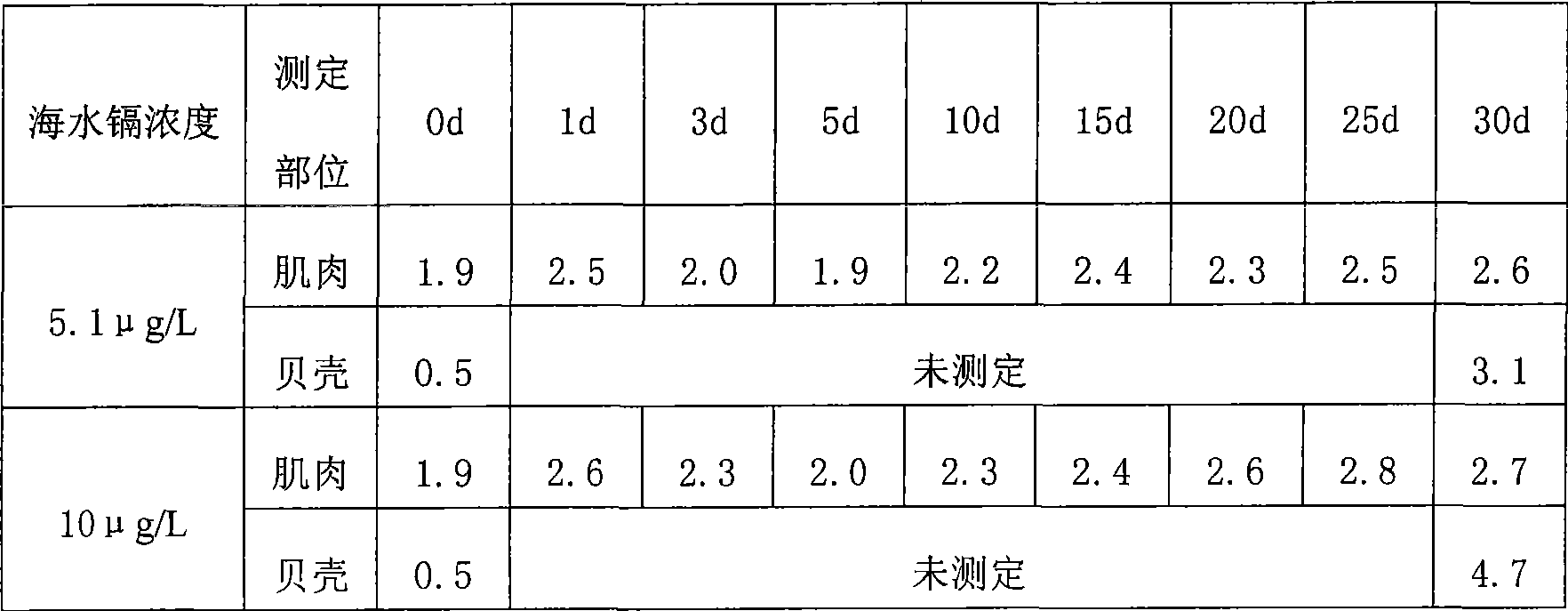Method for adsorbing seawater exceeding cadmium by cultivating blood clam
A seawater and mud cockles technology, applied in chemical instruments and methods, water/sludge/sewage treatment, applications, etc., can solve problems such as seawater pollution and achieve good economic results
- Summary
- Abstract
- Description
- Claims
- Application Information
AI Technical Summary
Problems solved by technology
Method used
Image
Examples
Embodiment 1
[0011] 1. Conditions: In the laboratory, the test seawater contains cadmium of 5.1μg / L and 10μg / L, the water is changed every 12 hours, (replace the seawater with the same cadmium concentration) oxygenated for 24 hours, and the room temperature is controlled at 22°C-26°C When changing the water every day, fish out the mud cockles with abnormal behavior or death. When changing the water in the morning, put the mud cockles into the solution containing Chlorella (the cadmium concentration of this solution is also the cadmium concentration of the test seawater) and feed for 0.5 hours. The test container is filled with 100L seawater, and 80 cockles are put into it.
[0012] 2. Method: Randomly take 5 cockles each time on 0 day, 1 day, 3 days, 5 days, 10 days, 15 days, 20 days, and 30 days, and detect the cadmium residue in the body: the experimental results are shown in Table 1:
[0013] Table 1 Data of cadmium residues in cockles over time (mg / kg)
[0014]
[0015] 3. Conclusi...
Embodiment 2
[0018] 1. Experimental conditions: In the laboratory, the concentration of cadmium in seawater is 25 μg / L and 50 μg / L, and the other conditions are the same, and the method is also the same.
[0019] Table 2 Change data of cadmium residues in mud cockles with time ((mg / kg)
[0020]
[0021]
[0022] 3. Conclusion:
[0023] At the same exposure concentration, the cadmium residues in mud clams generally increased with the increase of water exposure time, and the cadmium residue limit in mud clams after 30 days of the test did not meet my country's food hygiene and safety standards (3.0mg / kg). However, the sea water quality meets the national second-class water quality standard for aquaculture water.
[0024] Cockles with cadmium content exceeding the standard can be temporarily raised in natural seawater to release cadmium to meet the edible standard. The release test is as follows:
[0025] Each 20 mud cockles that have been raised in 25 μg / L and 50 μg / L seawater for 30...
Embodiment 3
[0028] Embodiment 3 comparative test:
[0029] In a farm in Yueqing, Wenzhou, a seawater sedimentation tank and a clam culture pond were changed at the same time. When the water was just changed, the concentration of cadmium in the seawater was 8.7 μg / L. After 5 days, the cadmium concentration in the seawater in the seawater sedimentation tank was 8.1 μg / L, and the cadmium concentration in the seawater in the mud cockle breeding pond was 1.3 μg / L. Adsorption of cadmium in seawater.
[0030] The instruments used in the above experiments are Varian AA240DUO atomic absorption spectrometer (with flame system and graphite furnace system) in the United States, and Milestone Ethos T microwave digestion instrument (with acid removal device) in Germany.
[0031] The detection of cadmium content in clam muscle refers to GB17378.6-2007 "Marine Monitoring Specification Part 6 Organism Analysis" "8.1 Flameless Atomic Absorption Spectrophotometry"; the detection of cadmium content in shell...
PUM
 Login to View More
Login to View More Abstract
Description
Claims
Application Information
 Login to View More
Login to View More - R&D
- Intellectual Property
- Life Sciences
- Materials
- Tech Scout
- Unparalleled Data Quality
- Higher Quality Content
- 60% Fewer Hallucinations
Browse by: Latest US Patents, China's latest patents, Technical Efficacy Thesaurus, Application Domain, Technology Topic, Popular Technical Reports.
© 2025 PatSnap. All rights reserved.Legal|Privacy policy|Modern Slavery Act Transparency Statement|Sitemap|About US| Contact US: help@patsnap.com



